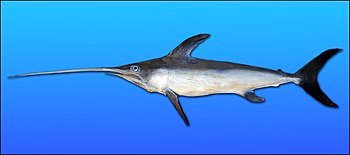
They commonly reach 3 m (10 ft) in length, and the maximum reported is 4.55 m (14 ft 11 in) in length and 650 kg (1,430 lb) in weight.The International Game Fish Association's all-tackle angling record for a swordfish was a 536 kg (1,182 lb) specimen taken off Chile in 1953. Females are larger than males, and Pacific swordfish reach a greater size than northwest Atlantic and Mediterranean swordfish.They reach maturity at 4–5 years of age and the maximum age is believed to be at least 9 years. The oldest swordfish found in a recent study were a 16-year-old female and 12-year-old male. Swordfish ages are derived, with difficulty, from annual rings on fin rays rather than otoliths, since their otoliths are small in size.
Behavior and ecology:-
The popular belief of the "sword" being used as a spear is misleading. Their nose is more likely used to slash at its prey to injure the prey animal, to make for an easier catch. The use as an offensive spear in case of dangers against large sharks or animals is under review.
Mainly, the swordfish relies on its great speed and agility in the water to catch its prey. It is no doubt among the fastest fish, but the basis for the frequently quoted speed of 100 km/h (60 mph) is unreliable.Research on related marlin (Istiophorus platypterus) suggest a maximum value of 36 km/h (22 mph) is more likely.
Swordfish are not schooling fish. They swim alone or in very loose aggregations, separated by as much as 10 m (35 ft) from a neighboring swordfish. They are frequently found basking at the surface, airing their first dorsal fin. Boaters report this to be a beautiful sight, as is the powerful jumping for which the species is known. This jumping, also called breaching, may be an effort to dislodge pests, such as remoras or lampreys.
.jpeg)